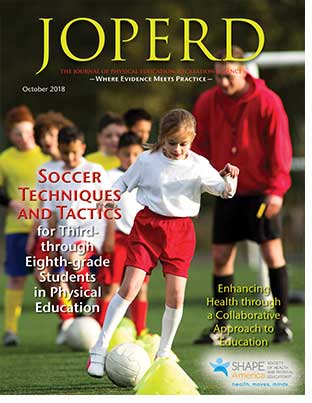 JOPERD Table of Contents
JOPERD Table of Contents
Effective Classroom Management in Physical Education: Strategies for Beginning Teachers
Dan Grube, Stu Ryan, Sarah Lowell, & Amy Stringer

Classroom management is often a big concern for beginning teachers. Beginning teachers worry about how they will uphold the same level of classroom management as veteran teachers. Frequently they worry about pleasing the students so that they will want to participate in their lessons. Often their biggest concern is how the students will behave and how to distribute the discipline when necessary. This approach is reactionary, akin to a referee calling fouls on players in a game (Graham, Holt/Hale, & Parker, 2013). According to Graham et al. (2013), a positive learning environment should be developed with a philosophy of “maintaining appropriate behavior.” To this end, beginning teachers are faced with
a tough task. These teachers must develop strategies that help to create an environment that is positive and conducive to learning — specifically, strategies that allow for a high amount of activity time coupled with clear and concise instructional segments. Learning to be efficient as a new teacher in a new environment can be a challenge, but it can make all the difference in accomplishing one’s goals and feeling successful.
Efficient use of time in physical education classes is critical given the limited amount of physical education that children receive in schools today. So it stands to reason that physical education teachers feel pressured to deliver as much physical activity as possible. Researchers have found that one third (Cousineau & Luke, 1990) or more (Kelder et al., 2003) of class time is spent on instructional and/or management tasks. Rink (2014) stated that it is surprising that only about one third of the time in physical education class is allocated to student activity. While these statistics vary, they indicate that there is an inefficient use of time by physical education teachers in their classes. Other studies have examined management plans that focus on minimizing transitions (Dawson-Rodrigues, Lavay, Butt, & Lacourse, 1997) and cueing exceptional students on activity changes (Rosenkoetter & Fowler, 1986). Adopting strategies for transitions will improve efficiency.
Another study looked at how teachers’ classroom management has changed over time (Garrahy, Cothran, & Kulinna, 2002). Despite the importance of classroom management, little information is available about how teachers gain and use knowledge about management in their classrooms. Garrahy et al. (2002) found that learning to manage one’s own classroom as part of a teacher’s developmental process was influenced by personal and contextual forces. The beginning teachers believed strongly in their wisdom of
practice and the wisdom of other colleagues’ practice and not the wisdom from their teacher education programs (Garrahy et al., 2002).
To read the rest of this article, click here to download a pdf.